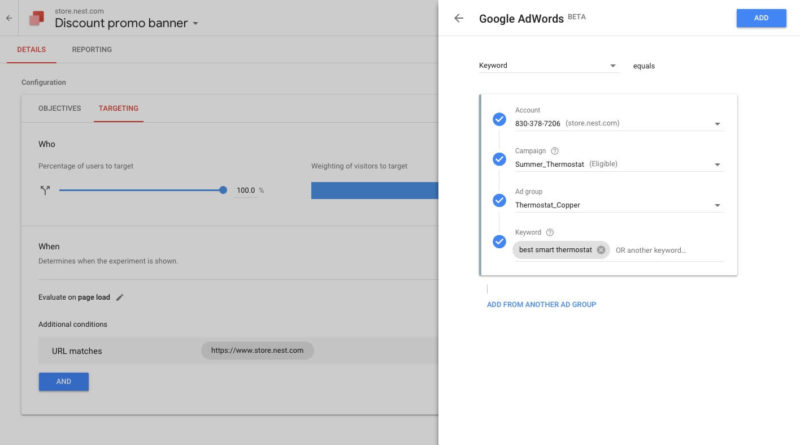 Pay-per-click (PPC) advertising often focuses too much on the click.
Pay-per-click (PPC) advertising often focuses too much on the click.
It sounds crazy. The industry is named after clicks, after all, but what happens after a user comes to your landing page is even more important.
That’s why the direct integration between AdWords and Google Optimize has me so excited. Landing page optimization is now way easier to do, which means that we can do so much more with all of those clicks that we’re paying for.
There’s a lot to get excited about when it comes to Google Optimize: It’s easy to set up experiments, and it’s even easier to create different versions of your site (no coding required). You can choose the winners of your tests with Google Analytics metrics and goals.
But as an AdWords guy at heart, I’m particularly excited about this integration: We can now directly tie our experiments to AdWords setups, from accounts all the way down to keywords.
Setting up Optimize and AdWords
Before we get into some of the ways to test AdWords with Optimize, I figure it makes sense to talk about how to set up an experiment.
To start, you’ll need to link your AdWords and Google Analytics accounts.
You’ll also have to enable auto-tagging in your ads. Once both of those are done, you have to check a box in the Linked Accounts section of your AdWords account to enable the link to Optimize.

It’s that simple.
Currently, you can run tests on search network traffic which includes search partners, shopping campaigns and Dynamic Search Ads. And within those campaigns, you can set up experiments for the following in Google Optimize:
- Accounts.
- Campaigns.
- Ad groups.
- Keywords.
AdWords components to test in Optimize
There really are a ton of things worth testing. Here is a list I came up with that may spark ideas for you.
1. How can you make a stronger connection with returning users?
You can get at this a couple of ways. The first is if you have already segmented out your remarketing lists for search ads (RLSA) traffic into their own campaigns.
If that’s the case, simply run tests on those campaigns. If your audiences are only applied to your campaigns as Bid-only, you simply have to combine the AdWords traffic you’re curious about with a Google Analytics (GA) audience list.

If you’re offering returning users special deals in your ad text, try making that offer the centerpiece of your landing page for those users.
And if you want to get really fancy with your offers, Optimize can do a real-time segmentation of returning visitors who have not made a purchase (via either GA or first-party cookies) versus returning customers who have made a purchase (via time since last purchase) with different discount codes from the same uniform resource locator (URL). Learn more about first-party cookie targeting here.
It’s a chance to offer deeper insight into your business, and you can test what works best.
2. Should you streamline your landing pages to improve your conversion rate?
This experiment contrasts with what I proposed above. Instead of growing the basket of top converters, think about how to turn average-performing ad groups and campaigns into top converters.
With Optimize, it’s simple to experiment with removing elements from your landing pages. Pick a campaign that’s doing OK but not great, and see if reducing the amount of information on your landing page helps people convert more easily. This is particularly important for mobile users, where you need to make your page fast and easy to check out.
Find the right balance between minimalism and information. People like to browse, but people also get distracted. Less can be more; and in this case, that could mean more clicks and sales.
3. How well do you know your exact-matched searchers?
Because you can set up experiments around specific keywords, you can tailor landing pages for users who arrived via exact-match keywords. While mirroring someone’s query on your site isn’t important for quality ratings per se, you have a neat opportunity to tailor your pages to specific keywords and match types.
One thing I’m curious about is what a match type might say about our level of insight with that user. A user doesn’t know what match type keyword you’re using to reach them, but you probably have a good amount of insight about users who arrive via an exact-match keyword like “chair rentals.”
How can you use that in your landing page tests? Should you be more direct? Are there certain products/packages that people are more likely to buy if they know more about your industry? You can cut to the chase based on your inferred knowledge about that person.
(And here’s a quick aside: Exact match isn’t inherently any more valuable than broad match. I’m talking here about the insights that you generated that led you to create a keyword as exact match.)
4. How can you enable different types of conversions?
Phone calls, website call conversions, newsletter signups, lead generation forms — they’re all valuable actions. If you track multiple conversion types, you should segment your reports by conversion action.
If a certain campaign is particularly call-heavy, create a version of your landing page that makes calling even easier. If an ad group drives all sorts of newsletters, take that ad group to a version of your page that highlights the newsletter, even if it’s at the expense of your main conversion action.
And this same logic applies to ad groups or campaigns that might be earlier in the conversion path. Look at your attribution reports and see which campaigns introduce people to your brand. You can add experimental changes to those pages that give people more information in lieu of trying to force a conversion that they aren’t ready for yet.
Understand how people convert, then tweak your pages to accommodate that conversion type.
5. What geographies might benefit from more regionally specific messaging?
You’ve surely spotted regional trends in your Google Analytics or AdWords data (like pop vs. soda). While those regional differences might not be severe enough to warrant a full landing page for that location, with Optimize you can make those changes yourself in a snap.
People speak differently and even enjoy different images in different places.
Using geotargeting in Optimize, you can experiment with regionally specific language that can deepen your connection with your users.
Conclusion
Now that testing has become easier, it can be easy to overdo it. Brainstorm with your team about what tests you think would be effective, then develop a framework for prioritization.
And remember, with any testing there will be plenty of tests that don’t show positive results. What matters is that you learn from each one of your tests so you can improve over time.
Contributing authors are invited to create content for Search Engine Land and are chosen for their expertise and contribution to the search community. Our contributors work under the oversight of the editorial staff and contributions are checked for quality and relevance to our readers. The opinions they express are their own.



